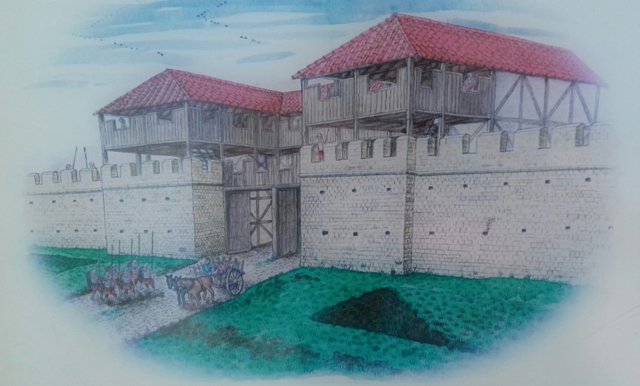The East Gate Of The Roman Fortress In Lincoln

AD 75
This is the site of the east gate of the Roman fortress and later city. The earliest gate to have stood here was part of the timber fortress built by the ninth legion around AD 60. The fortress was defended by a rampart of the earth behind a wooden palisade with guarded gateways in each of the four sides. The gates were rebuilt and strengthened around AD 71. The drawing shows how the east gate might have looked like at this time.

AD 150
The Roman army left Lincoln around AD 79 and by the year 100 the fortress was being rebuilt as a Colonia. A town for retired army veterans. It was called Lindum Colonia which has been shortened over the centuries to Lin-coln. The timber palisades of the fortress were replaced with stone walls and the gateways were strengthened and improved, although still based on their original layout.

AD 300
Lindum Colonia developed into a very high status city and grew southwards down the hillside to the river (the lower city). In the early 200's the gateways were rebuilt in monumental style. The east gate had semicircular fronted towers with two great stone arched entrances. The view through the gate was designed to impress and travellers could have glimpsed the grand colonnade of the forum as they approached the city. During the 300's Roman Lincoln declined in importance and when the Romans finally withdrew from Britain in 410 the city slipped into decay.

AD 1150
Lincoln's Roman defences survived through the centuries and the upper city walls were reused for the outher defence of Lincoln Castle (The Bail) built by William the conqueror in 1068. The east gate was remodelled at this time and new archways created, but this designed soon changed when around 1130 Henry I. gave the gate to Bishop Alexander with permission to convert it into a lodging. Only the southern arch stayed in use. The drawing shows how the east gate might have looked around 1150. Part of the blocked Roman arch was still visible and the Bishop's new lodging has taken over the gatehouse.

The Ruin
The ruin that you see here is part of the eastern gateway into Roman Lincoln. Several gateways have stood on this spot starting with a wooden gate to the Roman fortress, built in about AD 60. The wooden posts inside the ruin mark the positions of timbers from this early gate.
The stone ruin is the base of the semicircular tower - it was one of a pair (the other is under the road) which flanked two arched gateways. You can see a doorway into the tower and the start of a flight of steps leading to the upper storeys. Built in the early 200's, this was the last and the grandest Roman gateway on this spot. It stayed in use after the Romans had left Lincoln.
These remains were excavated 1963-66 and are now preserved as an ancient monument.


I’ve visited a lot of Roman ruins in my time, in the UK and Europe, and it always fascinated me. Chedworth Roman Villa, Gloucestershire was a good one and of course the Roman Baths in Bath. There’s loads around the UK though and other places. I think many people don’t understand the extent at which the Romans held Britain. Some 300-400 years I believe. Not a long time as far as Hillman history goes, but long enough to have left an indelible mark to this day.
I am always fascinating about these old ruins or monuments. I always read the history behind them to get the idea what I am looking at. People often say what are you looking at those stones for that long. For me they are not just stones becuse if they could speak they would tell a lot.
Posted using Partiko Android